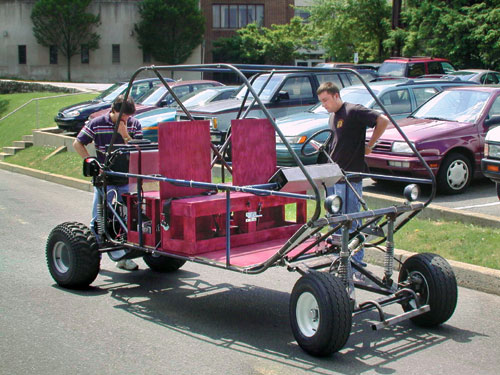A Lafayette team of eight mechanical engineering majors finished second among four schools in the Basic Utility Vehicle (BUV) Design Competition sponsored by the Institute for Affordable Transportation (IAT) in Brazil, Indiana on May 26.
At an estimated cost of $1,575.53 (without labor), the vehicle was designed with low-income families from Third World countries in mind. The goal of the competition is to develop a BUV that will reduce poverty by facilitating transportation and trade.
The BUV design project was completed under the guidance of Steven Nesbit, associate professor and head of mechanical engineering, and Terry DeRossett, director of mechanical engineering laboratories, by seniors George Hartman (Hatboro, Pa.), Michael Pfeffer (Merion Station, Pa.), Ran Reske (Nairobi, Kenya), Brad Hollub (Northbrook, Ill.), Beth Rousseau (Weston, Mass.), Andrew Bennett(Fair Haven, N.J.), Adam Zwirn (Huntingdon Valley, Pa.), and Matt Carney (New Fairfield, Conn.).
A series of tests and evaluations were conducted to evaluate the vehicles at the competition, such as handling steep inclines and making trails.
“Overall, the Lafayette students did a great job,” says Will Austin, director of IAT. “They had such a ‘can do’ attitude. There were certain events that we didn’t think their vehicle could do. For each one, they insisted that they try. They made it through every time, even if the vehicle had to be redirected and adjustments made.”
Lafayette’s vehicle had the most cargo space and most comfortable ride. “Its ability to go full speed and over bumps was great. They also put a lot of thought into shipping the vehicle — making it easy to take apart and put together,” adds Austin. “It’s a good-looking vehicle.”
The BUV weighs less than 550 lbs, can travel on unpaved roads, achieves speeds of at least 25 miles per hour, and handles inclines of at least 10 degrees. Automatic gear shifting is provided by a clutch through centrifugal force, and an independent suspension system keeps each side of the vehicle moving separately. The floor and seats are made from plywood and two-by-fours, with the seats covered by outdoor cushions used for lawn chairs; items can be stored beneath them. The BUV carries four passengers and has a trailer hitch. It also can provide power to devices such as a pump or compressor.
The parts were designed to be shipped in a crate for easy assembly. The BUV passed this test when Bennett put it together with a screwdriver.
The students paired up to design the various components of the BUV during the first semester, then brought their plans together for construction in the spring semester. “When people were doing their own thing, we found that adjustments were needed,” says Carney. “We’ve done a lot of problem solving as a group.”
The students chose to design a vehicle from scratch rather than modifying an existing vehicle. “We decided as a group that it would be more interesting, and we would get more out of it, if everything that we had was what we designed,” Carney explains. “Professor Nesbit has been a great help. He knows everything about cars and brought up things we wouldn’t have realized until after the fact. He’s kept us from wasting our time.”
IAT wants to use Lafayette’s vehicle to promote next year’s competition and to refine designs for a BUV that will be shipped to Third World countries in large quantities by the end of 2003.

Eight mechanical engineering seniors designed a Basic Utility Vehicle for easy assembly and disassembly.
